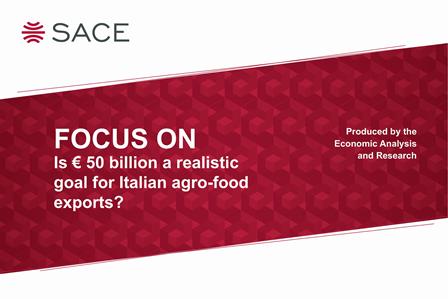
 Umberto Mucci
Umberto Mucci
Italian good news: Is € 50 billion a realistic goal for Italian agrifood exports?
- WTI Magazine #57 Apr 03, 2015
-

 Umberto Mucci
Umberto Mucci
WTI Magazine #57 2015 April, 3
Author : SACE Translation by:
ITALIAN FOODS: GROWTH SLOWING IN INTERNATIONAL MARKETS
Italian exports of agro-food products totaled € 33 billion in 2013. This value is significant but the country has a great potential yet to be exploited. Compared to our principal peers, European and worldwide, on the one hand, Italy increased the ratio of agro-food exports to total goods exported (+1.9%); on the other hand it didn't surpass other countries with a historically strong position in agro-food market, such as Spain and France. (Fig. 1).
FIGURE 1. Agro-food product exports as a percent of total exported goods: a comparison between Italy and its peers in 2007, 2010, 2013 (%)
Our agro-food exports have grown in recent years despite the highly unfavorable international economic context. Average annual growth between 2010 and 2013 was 6.4%, better than the 4.7% of the previous three years. Italy's performance has been positive in non-EU emerging markets (+15.1%), demonstrating the good results that can be achieved in countries with a greater potential for increasing demand (Fig.2); our exports to EU emerging and advanced markets, instead, grew at a slower pace than our peers (respectively +6.7% and +4.4%, between 2010 and 2013).
LEADERS AND FOLLOWERS IN THE TOP ITALIAN AGRO-FOOD CATEGORIES
Italy has a 3.1% world market share in agro-foods, in line with Spain but less than those of other competitors (included between the 4.6% of the China and the 10.3% of the United States).
Selecting the ten strongest sectors of our agro-food exports (which represent 57% of total Italian agro-food exports), the results differ widely depending on the category and segment, with peaks of excellence for pasta (37.5%), olive oil (25%), and wines (19.3%). Italy is also well positioned in "less known" sectors such as fresh fruit (especially apples and pears), processed meats, cheeses and dairy products, and canned goods. But except for pasta, where our country is the unquestioned world leader, in the other major sectors of Italian agro-business we are challenged, and often surpassed, by other countries less known in the international arena for the quality of their food products.
Germany has a greater market share in cheeses and dairy products business..., processed meats and coffee, the United States and China in canned goods and fresh fruit,and the competition with France in wines and with Spain in olive oil has surfaced in the past decade.
THE POSSIBLE COMEBACK: € 40 MILLION BY 2018, SO WHY NOT 50 BY 2020?
This seems like a propitious time for recovering our competitiveness in the international markets: the economic recovery of countries with a high demand for Italian products, signs of confidence from the national business community, new liquidity due to imminent quantitative easing, depreciation of the euro against the dollar and Swiss franc, and EXPO 2015 as a showcase for Italy and the world. This recovery will require an ability to focus efforts on a few significant categories where we can combine Italian quality with economies of scale and international standards.
If we concentrate especially on the ten sectors and segments mentioned above, intensifying penetration in the most promising markets for each product category (fast-growing importers), current Italian agro-food exports could be increased by over € 7 billion by 2018. (Potential incremental export volume is calculated by assuming that Italian exports of each agro-food product will grow by 2018 at the same rate as registered in 2011-2013. When growth dynamic is stronger in the imports of agro-food products, Italian exports are assumed to grow at the same rate as related imports in 2011-2013. In some cases, the possible gain had to be limited by assuming an annual value equal to 30% of Italian exports to the country in the last year for which data are available (2013).
In Europe, where common, harmonized rules and standards exist, € 4.8 billion in additional exports could be achieved, with € 1.4 billion in the Americas. The United States, Germany, the United Kingdom and France alone could absorb € 5 billion in additional exports. The opportunities, also regard some emerging markets where consumer preferences are increasingly oriented toward the quality of Italian products. These countries include China, Hong Kong, South Korea, Brazil, Poland and Egypt. The picture is somewhat different for Russia, an important market for our agro-food exports, which is experiencing the negative effects of sanctions on its economy and its ban on imports of certain sector products. Estimates clearly indicate that the potential gains for exports to that country would be significant without those restrictions.
Among the ten selected markets, wines, canned goods, and olive oil are the highest-potential segments, since they account for over 50% of the potential incremental exports (€ 3.9 billion). In Fact, these products can combine Italian quality with industrial production processes capable of satisfying growing international demand.
Considering that Italian agro-food exports totaled € 33 billion in 2013, they could therefore reach over € 40 billion, confirming the goal of 50 could be achieved by 2020, focusing efforts directly on the markets of opportunity and on individual product categories.
FROM WORDS TO DEEDS: INSURANCE-FINANCIAL INSTRUMENTS TO DRIVE EXPORT.
The search for opportunities in the markets mentioned above will require a major strategic effort. In mature markets like the United States, Germany, the United Kingdom and France, agro-food companies must focus on becoming more competitive, which means not only product quality but also selecting the proper distribution channels and adopting effective marketing and brand-enhancement instruments, avoiding to ignore the ability to offer their customers financially advantageous payment conditions and terms.
In the lesser-known markets, an additional effort will be required to understand local dynamics from several standpoints. The distinctive characteristics of Italian food products are valuable features and a limitation at the same time, unless they are managed in a way that fits the context: a flavor that captures the French palate may not necessarily meet with the same success in China or Korea, for example.
The Advisory services developed by SACE help companies assess whether their approach to the individual markets and the various risk profiles is appropriate and to propose financial and insurance structures that will effectively support their individual commercial and investment transactions. The agro-food industry is composed primarily of small and midsize companies that might be unable to manage the risks of internationalization on their own and obtain adequate access to financing. Choosing the right partner, like SACE, to control and manage all the risks associated with internationalization—from payment default to events of a political nature—enable companies, especially those lacking the necessary structures, to focus on business and the competitiveness of their commercial offering in the target countries. This does not shorten the distancesbut truly facilitates the process.
PREPARED BY Eleonora Padoan. Special thanks to Stefano Gorissen